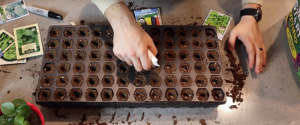Alfalfa Sprouts

Health Power
Health benefits come from phytonutrients not vitamins and minerals, which are in trace amounts except for vitamin K. Nutrient quantity low if eating only a few sprouts in salads or sandwiches. More concentrated dose comes from juicing. Phytonutrients include an amino acid derivative, canavanine, plant estrogens and saponins. Early studies of canavanine suggest it may help fight leukemia and cancers of the colon and pancreas. Abundant plant estrogens may support bone formation and inhibit deterioration. May also protect against many cancers (ex. breast, bowel and prostate). Saponins lower bad cholesterol (LDL) and help stimulate parts of immune system.
Vitamin and Mineral Content
Vitamins – K, C and traces
Minerals – Copper, Manganese and traces
Disease Prevention
Sprouts or juice may help prevent or reduce symptoms of osteoporosis, atherosclerosis, cardiovascular disease and many cancers.
How to Grow
A perennial legume requiring soil with good drainage and pH near 6.5. Can be used as green manure and added to soil as nitrogen-rich organic matter. Many farmers plant these cover crops after fall harvest, let grow over winter and till in spring. Excellent way to maintain soil tilth, organic matter and nutrient content. Other gardeners or farmers work alfalfa into crop rotation plan to help restore soil fertility during part of year. Sow in spring. Till into soil in fall. In warmer climates, sow in fall and till in spring. Sowing for food is fun project. Use sterile, clear, quart glass jar, seeds, cheesecloth or other filter material with small pores for draining, rubber band and windowsill or sunny indoor location. Put tablespoon of seeds in glass jar. Cover seeds with lukewarm filtered water to 1-2 inches above seeds. Secure filter material (cheese cloth or pantyhose) around top with rubber band. Let seeds soak overnight. Drain jar the next day by inverting over sink, leaving only enough moisture to keep seeds damp. They grow best in 70-80˚F. Place jar in the dark undisturbed for four days. Each day, remove seeds and rinse with quality water up to three times a day. Drain out so seeds are damp but not soaked. Watch seeds turn white and grow several inches over a few days. After rinsing and draining on day 4, place sprouts on a tray on windowsill or sunny spot. In 15 minutes they turn green and are ready to eat.
Insect Control
Jar is protected from pests, which are not usually a problem.
Tips
For continual supply of sprouts, start a new jar every few days. Phytonutrient content of sprouts is highest after setting them in the sun and letting leaves turn green.
___________________________________________________________________________________
What do you need to start indoor growing?
It’s easy to buy your transplants from the garden center each season, but there are lots of reasons to sprout your own seeds at home. It will save a substantial amount of money, you’ll have access to a wider range of plant varieties, and you’ll have the satisfaction of seeing a plant through its full life cycle. But if you’re a new seed sprouter. It’s really quite simple once you understand the basics. So if you’re ready to get sprouting, here are the basic steps to follow.






